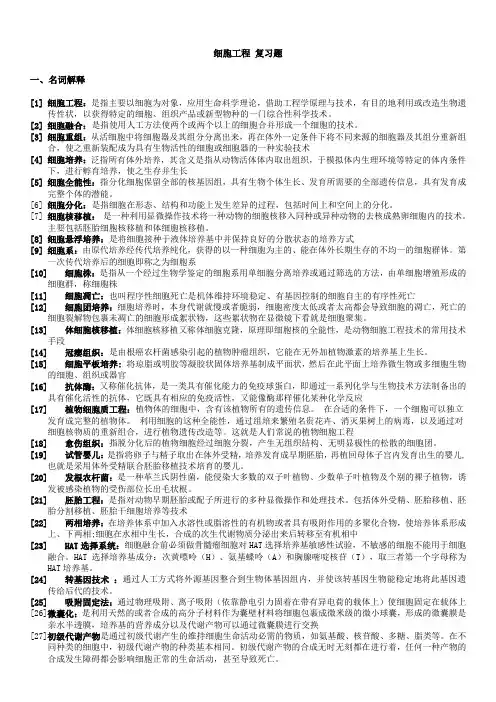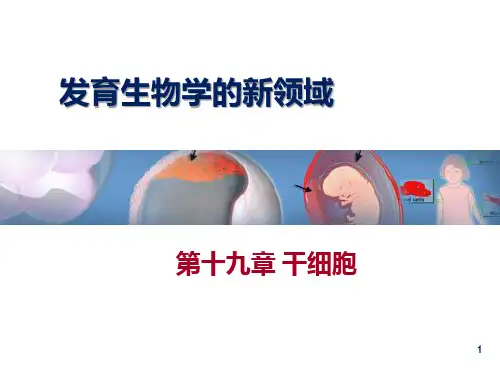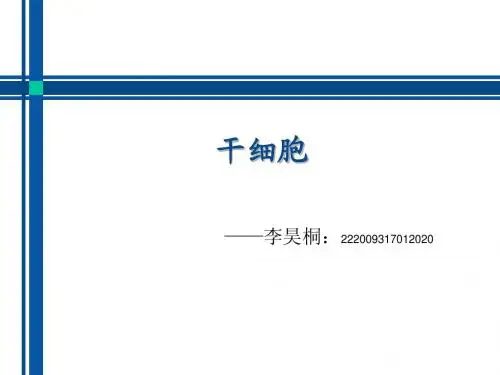干细胞工程
- 格式:doc
- 大小:37.00 KB
- 文档页数:3

细胞工程复习题一、名词解释[1]细胞工程:是指主要以细胞为对象,应用生命科学理论,借助工程学原理与技术,有目的地利用或改造生物遗传性状,以获得特定的细胞、组织产品或新型物种的一门综合性科学技术。
[2]细胞融合:是指使用人工方法使两个或两个以上的细胞合并形成一个细胞的技术。
[3]细胞重组:从活细胞中将细胞器及其组分分离出来,再在体外一定条件下将不同来源的细胞器及其组分重新组合,使之重新装配成为具有生物活性的细胞或细胞器的一种实验技术[4]细胞培养:泛指所有体外培养,其含义是指从动物活体体内取出组织,于模拟体内生理环境等特定的体内条件下,进行孵育培养,使之生存并生长[5]细胞全能性:指分化细胞保留全部的核基因组,具有生物个体生长、发育所需要的全部遗传信息,具有发育成完整个体的潜能。
[6]细胞分化:是指细胞在形态、结构和功能上发生差异的过程,包括时间上和空间上的分化。
[7]细胞核移植:是一种利用显微操作技术将一种动物的细胞核移入同种或异种动物的去核成熟卵细胞内的技术。
主要包括胚胎细胞核移植和体细胞核移植。
[8]细胞悬浮培养:是将细胞接种于液体培养基中并保持良好的分散状态的培养方式[9]细胞系:由原代培养经传代培养纯化,获得的以一种细胞为主的、能在体外长期生存的不均一的细胞群体。
第一次传代培养后的细胞即称之为细胞系[10]细胞株:是指从一个经过生物学鉴定的细胞系用单细胞分离培养或通过筛选的方法,由单细胞增殖形成的细胞群,称细胞株[11]细胞凋亡:也叫程序性细胞死亡是机体维持环境稳定、有基因控制的细胞自主的有序性死亡[12]细胞团培养:细胞培养时,本身代谢就慢或者脆弱,细胞密度太低或者太高都会导致细胞的凋亡,死亡的细胞裂解物包裹未凋亡的细胞形成絮状物,这些絮状物在显微镜下看就是细胞聚集。
[13]体细胞核移植:体细胞核移植又称体细胞克隆,原理即细胞核的全能性,是动物细胞工程技术的常用技术手段[14]冠瘿组织:是由根癌农杆菌感染引起的植物肿瘤组织,它能在无外加植物激素的培养基上生长。
![《细胞工程原理及技术》竞赛全套-6[1]干细胞工程](https://uimg.taocdn.com/5f32657e0740be1e650e9aaa.webp)

组织与细胞工程中干细胞再生医学新进展干细胞再生医学是当前医学领域的一个热门研究方向,它具有巨大的潜力来治疗各种疾病和创伤,并为患者带来新的希望。
在组织与细胞工程中,干细胞再生医学正迎来新的进展,为人类健康带来了许多重要的突破。
本文将介绍干细胞的定义、分类以及干细胞再生医学的最新进展。
首先,我们来了解一下什么是干细胞。
干细胞是一类具有自我更新和多潜能分化能力的特殊细胞。
它们可以通过不同的分化路径生成各种特定的细胞类型,并且可以自我复制以不断补充其数量。
干细胞通常分为两类:胚胎干细胞和成体干细胞。
胚胎干细胞是从早期胚胎中获得的,具有最广泛的分化潜能。
它们可以分化为所有体细胞类型,并具有巨大的再生潜力。
然而,胚胎干细胞的获取和应用伦理问题备受争议,限制了其在临床应用中的使用。
与此相反,成体干细胞存在于成年生物的各个组织和器官中,具有一定的分化潜能。
它们主要用于维持和修复组织,是体内的自然修复系统。
成体干细胞相对于胚胎干细胞更容易获取,且不涉及伦理争议,因此在干细胞再生医学中得到广泛应用。
在组织与细胞工程领域,干细胞再生医学取得了一系列新的进展。
首先,研究人员发现了一种名为诱导多能干细胞(induced pluripotent stem cell,iPSC)的新型干细胞。
iPSC 是通过基因工程技术将成体细胞重编程而来的多能性细胞,具有类似于胚胎干细胞的特性。
iPSC 的发现带来了一种新的获得干细胞的方法,解决了胚胎干细胞获取和伦理问题,为干细胞再生医学的应用打开了新的大门。
其次,利用干细胞进行组织工程也取得了显著进展。
组织工程是一种将多种细胞和生物材料结合起来,利用干细胞的再生能力来修复或重建组织和器官的方法。
通过培养和进一步分化干细胞,研究人员已经成功制备出许多具有生物学功能的组织,如心肌组织、神经组织和肝脏组织等。
这些组织工程构建的组织不仅可以在实验室中进行研究,还可以在临床上应用于治疗患者,为细胞治疗提供新的选择。






干细胞技术在组织工程及再生医学中的前景展望引言干细胞技术作为一项颠覆性的医学科技,被广泛研究和应用于组织工程及再生医学领域。
通过利用干细胞的多潜能性和自我更新能力,人们可以再造、修复和替代受损组织和器官,带来巨大的医学和生物学进展。
本文将展望干细胞技术在组织工程及再生医学中的潜力和前景。
一、干细胞技术的进展1.1 干细胞的定义和分类干细胞是一类具有自我更新和多向分化潜能的细胞,可分为胚胎干细胞和成体干细胞两大类。
胚胎干细胞来源于胚胎早期的内细胞团,具有高度分化和广泛分化潜能;而成体干细胞存在于成人的多个组织和器官中,包括骨髓、脂肪组织、神经组织等。
1.2 干细胞技术的发展历程干细胞技术的研究始于20世纪70年代,经过几十年的努力,科学家们已经成功地分离和培养出多种干细胞,并实现了不同组织和器官的再生。
干细胞技术的进展为组织工程和再生医学领域带来了希望和机遇。
二、组织工程中的干细胞应用2.1 干细胞在组织工程中的重要性组织工程是一种利用生物材料和细胞来构建人工组织和器官的技术,而干细胞作为具有多潜能性和自我更新能力的细胞,被广泛应用于组织工程领域。
干细胞可以不断分化为各种特定细胞,从而实现器官和组织的再生和修复。
2.2 干细胞在组织工程中的应用案例干细胞在组织工程中的应用案例多种多样,涉及到多个器官的再生。
例如,干细胞可以应用于心肌再生,通过植入干细胞诱导它们分化为心肌细胞,以修复心肌缺损。
此外,干细胞还可以应用于骨骼再生、肝脏细胞再生、皮肤再生等领域,为受损的组织和器官提供新的生物材料和细胞来源。
三、再生医学中的干细胞应用3.1 干细胞在再生医学中的潜力再生医学是一种通过利用干细胞和组织工程技术来再造受损组织和器官的医学科学。
干细胞作为再生医学的核心组成部分,具有重大潜力。
通过干细胞的多向分化潜能,可以再造多种类型的细胞,从而为疾病治疗和组织修复提供新的方法和途径。
3.2 干细胞在再生医学中的应用前景再生医学是目前科学研究和临床实践的热点领域之一,干细胞作为再生医学的核心技术,具有巨大的应用前景。

Cancer stem cells are defined as those with the ability to self-renew while generating a daughter progenitor. They are malignant for the progenitor to undergo further differentiation into more mature progenitors into phenotypically diverse cancer cells. To cure cancer it is imperative to devise therapies that effectively target the cancer stem cells.iPS cells, namely induced pluripotent stem cells, were first produced in 2006 from mouse cells and in 2007 from human cells. They are a type of pluripotent stem cell artificially derived from a non-pluripotent cell, typically an adult somatic cell, by inducing a "forced" expression of specific genes, such as oct4, sox2, nanog, klf4, c-myc and so forth. They are similar to natural pluripotent stem cells, such as ES cells, in many respects, such as the expression of certain stem cell genes, chromatin methylation patterns, doubling time, embryoid body formation and potency of differentiability, but the full extent of their relation to natural pluripotent stem cells is still being assessedcell reprogramming, is the process of directing mature cells to a primitive state of gene expression. Somatic cell nuclear transfer, cell fusion, and introduction of specific transcriptional factors are three main strategies of cell reprogramming.stem cells are biological cells that can differentiate into diverse specialized cell types. There are two types of stem cells: embryonic stem cells that are isolated from the inner cell mass of blastocysts, and adult stem cells that are found in various tissues. The classical definition of a stem cell requires it possess two properties: self-renewal - the ability to go through numerous cycles of cell division while maintaining the undifferentiated state. Potency - the capacity to differentiate into specialized cell types. In the strictest sense, this requires stem cells to be either totipotent or pluripotent - to be able to give rise to any mature cell type, although multipotent or unipotent progenitor cells are sometimes referred to as stem cells.Epigenetic is the study of heritable changes in phenotype or gene expression caused by mechanisms other than changes in the DNA sequence. These changes may remain through cell divisions for the remainder of the cell's life and may also last for multiple generations. However, there is no change in the underlying DNA sequence of the organism; instead, non-genetic factors cause the organism's genes to behave differently.Embryonic stem cells are pluripotent stem cells derived from the inner cell mass of the blastocyst, an early-stage embryo. They have two distinctive properties: the pluripotency of differentiation, and the capacity of self-renewal. They can differentiate into all derivatives of the three primary germ layers, which include more than 220 types of cells in the adult body. They also can maintain their undifferentiated state when they are in the continuous process of division.gene targeting is a genetic technique that uses homologous recombination to change an endogenous gene. The method can be used to delete a gene, remove exons, add a gene, and introduce point mutations. Gene targeting can be permanent or conditional. Gene targetingrequires the creation of a specific vector for each gene of interest. However, it can be used for any gene, regardless of transcriptional activity or gene size.可塑性plasticity refers to the ability of a cell to change its phenotype in response to changes in the environment.Somatic cells nuclear transfer is a laboratory technique for creating a clonal embryo, using an ovum with a donor nucleus. It can be used in embryonic stem cell research, or in regenerative medicine, such as "therapeutic cloning". It can also be used as the first step in the process of reproductive cloning, but it will break human ethics if it is applied in human cloning.Genomic imprinting is a mark about parental origin, namely a genetic phenomenon by which certain genes are expressed in a parent-of-origin-specific manner. It is an inheritance process independent of the classical Mendelian inheritance. Imprinted genes are either expressed only from the allele inherited from the mother , or from the allele inherited from the father. It is also an epigenetic process that involves methylation and histone modifications in order to achieve gene expression without altering the genetic sequence. These epigenetic marks are established in the germline and are maintained throughout all somatic cells of an organism.Transdifferentiation is an irreversible switch of one differentiated cell type to another. It takes place when a non-stem cell transforms into a different type of cell, or when an already differentiated stem cell creates cells outside its already established differentiation path. It is a type of metaplasia, which includes all cell fate switches, including the interconversion of stem cells.Stem cell niche is the microenvironment in which stem cells are found, which interacts with stem cells to regulate stem cell fate. Niche can be in reference to the in vivo or in vitro stem cell microenvironment. During embryonic development, various niche factors act on embryonic stem cells to alter gene expression, and induce their proliferation or differentiation for the development of the fetus. Within the human body, stem cell niches maintain adult stem cells in a quiescent state, but after tissue injury, the surrounding micro-environment actively signals to stem cells to either promote self renewal or differentiation to form new tissues.Aseptic technique refers to a procedure that is performed under sterile conditions. This includes medical and laboratory techniques, such as with microbiological cultures. It includes techniques like flame sterilization.自我更新self-renew means that embryonic stem cells can maintain their undifferentiated state when they are in the continuous process of division. It is the distinctive prosperity of embryonic stem cells or iPS cells.分化differentiation is the process by which a less specialized cell becomes a more specializedcell type. Differentiation occurs numerous times as the organism grows from a simple zygote to a complex system of tissues and cell types. Differentiation dramatically changes a cell's size, shape, membrane potential, metabolic activity, and responsiveness to signals. It is under the exact and rigorous control of the expression of various genes.细胞周期The cell cycle is the series of events that takes place in a cell leading to its division and duplication. It can be divided in two brief periods: interphase, during which the cell grows, accumulating nutrients needed for mitosis and duplicating its DNA; and M phase, during which the cell divides into two distinct cells . The cell cycle is a vital process by which a zygote develops into a mature organism, as well as a process by which various tissues and organs are renewed.治疗性克隆therapeutic cloning means using the technique of cloning to create embryos in the laboratory for medical purposes. The use of cloning techniques to obtain human embryos is in order to extract embryonic stem cells or pluripotent stem cells. These stem cells, in the right conditions, can develop into any types of cells, issues as well as organs, which can be used for medical treatment.。

协和干细胞基因工程工艺流程干细胞基因工程可是超级酷的一个领域呢!那咱就来说说协和的干细胞基因工程工艺流程吧。
一、干细胞的采集。
干细胞这东西,可不是随随便便就能拿到的。
对于协和来说呀,干细胞的采集那可是有严格的标准和方法的。
比如说,要是采集造血干细胞呢,就会从合适的供者那里,可能是骨髓里,也可能是外周血里采集。
骨髓采集听起来有点吓人,但其实在专业医生的操作下,也是比较安全的。
就像从一个神秘的宝藏里小心翼翼地取出宝贝一样。
外周血采集相对就温和一些啦,就像是从河流里筛选出我们想要的那种特殊的“小颗粒”,这个小颗粒就是干细胞啦。
还有呢,如果是间充质干细胞,可能就会从脐带或者胎盘这些地方采集,这些地方可是干细胞的小窝呢,就像从宝宝出生后的特殊小礼物里找到干细胞这个珍贵的礼物一样。
二、干细胞的分离。
采集到的干细胞和其他细胞都混在一起呢,就像一群小伙伴在一个大房间里玩耍。
那怎么把干细胞找出来呢?这就需要分离啦。
协和采用的方法就很巧妙。
他们会利用细胞的一些特性,比如说大小呀,密度呀这些。
就好比是按照身高和体重把小伙伴们分成不同的小组。
通过一些特殊的仪器和试剂,那些干细胞就被乖乖地从大杂烩里分离出来啦。
这个过程就像是一场有趣的筛选游戏,把干细胞这个小主角从一群细胞群众里给挑出来。
三、干细胞的培养。
分离出来的干细胞可娇弱啦,得好好照顾它们。
在协和的实验室里,会给干细胞提供一个超级舒适的小环境来培养它们。
这个小环境里有合适的温度、湿度,还有营养物质,就像给干细胞打造了一个五星级的小窝。
培养基就像是给干细胞准备的特制美食,里面有各种各样它们需要的营养成分。
在这个小窝里,干细胞就像小婴儿一样开始慢慢长大、繁殖。
而且呢,还要随时关注它们的状态,就像照顾自己的小宠物一样,要看看它们是不是长得健康,有没有什么异常情况。
四、基因工程操作。
当干细胞培养得差不多的时候,就可以进行基因工程操作啦。
这一步就像是给干细胞进行超级变身。
比如说,可能会通过一些特殊的技术把一些有用的基因导入到干细胞里,或者对干细胞本身的基因进行一些修改。
干细胞工程技术
干细胞工程技术主要包括以下部分:
1.干细胞的体外培养和增殖技术:通过在一定的培养条件下,使干细胞能够在体外进行增殖和分化,形成任何类型的组织和器官。
2.干细胞的移植和诱导分化技术:将干细胞移植到受体中,并诱导其分化为特定的组织或器官类型,以实现组织和器官的修复和再生。
3.基因工程和转基因技术:通过基因工程和转基因技术,对干细胞进行遗传改造,以增加其增殖和分化能力,或使其具备特定的功能。
4.干细胞库的建立和管理:建立和管理干细胞库,以保存和提供高质量的干细胞供研究和应用。
5.干细胞药物的开发和临床试验:开发和进行干细胞药物的临床试验,以研究其在治疗各种疾病中的应用和效果。
百企入桂干细胞工程说明书“百企入桂”--带动非公有制经济发展的“干细胞工程”■广西著名的招商引资品牌,是一种创新的招商模式;■引进的都是民营企业,民营资本(个体资本);■引进的民营企业像酵母一样,引来发酵;■不是引进多少家企业,而是引进了多少人?■“百企入桂”构筑广西的投融资平台,广泛吸纳社会民间资本。
2009年1月10日在广西壮族自治区第十一届人民代表大会第二次会议上自治区主席马彪我们既要充分认识形势的严峻性,对困难局面以及今后可能加重的情况有充分的估计和思想准备;既要充分把握今年面临的机遇,增强战胜困难的信心和决心,以非常办法、非常措施、非常力度、非常政策。
化压力为动力。
化挑战为机遇,化危机为转机,采取超常的方式,只挣朝夕,争分夺秒,扎实工作,推动经济社会又好又快发展。
“百企入桂”名称的由来:2001年7月,全国政协副主席,统战部部长刘延东到广西考察,自治区党政领导与刘延东同志交换了意见,一致认为,选择民营资本进入广西,符合广西区情。
随后,自治区领导专门召开会议,刘奇葆等自治区领导召集党委、政府20多个部门开会进行动员,就开展活动的意义、组织、工作对象、重点、方法等进行部署,成立工作机构。
这就是“百企入桂”活动产生的内幕。
2001年8月自治区党委、自治区政府作出了一个最大决策:加快发展我区民营经济、个体经济,在全区范围内开展全方位、多渠道引进区外有实力的民营企业和个体前来投资合作的招商活动。
这就是“百企入桂”名称的由来。
“百企入桂”————带动非公有制经济发展的“干细胞工程”(自治区书记刘奇葆)开展“百企入桂”是加快广西经济发展的重要措施,“百企入桂”是在自治区党委、政府领导下,有关部门与地方分工合作,提供全程跟踪和专门服务,有针对性的引进一批有实力的民营企业和个体来广西考察、投资和发展,并通过这些企业和个体的带动作用,引导和加快民营经济发展的一项专题工作。
开展“百企入桂”活动,有效实现了社会资源和经济资源的整合,收到显著效果。
干细胞的研究及应用
摘要;由于干细胞具有特定的分化潜能,表现其全能性、多能性和专能性,近几年来世界各国科学家对干细胞的临床应用研究已取得很大的进展。
干细胞是目前细胞工程研究最活跃的领域,随着基础研究、应用研究的进一步深化,这项技术将会在相当大程度上引发医学领域的重大变革,它已成为 21世纪生命科学领域的一个热点。
本人将对干细胞及其应用前景展开论述。
关键词:干细胞应用前景
干细胞具有无限制自我更新能力、同时也可分化成特定组织的细胞,在细胞发育过程中处于较原始阶段。
干细胞(stem cells, SC)是一类具有自我复制能力(self-renewing)的多潜能细胞,在一定条件下,它可以分化成多种功能细胞。
根据干细胞所处的发育阶段分为胚胎干细胞(embryonic stem cell,ES细胞)和成体干细胞(somatic stem cell)。
根据干细胞的发育潜能分为三类:全能干细胞(totipotent stem cell,TSC)、多能干细胞(pluripotent stem cell)和单能干细胞(unipotent stem cell)。
干细胞(Stem Cell)是一种未充分分化,尚不成熟的细胞,具有再生各种组织器官和人体的潜在功能,医学界称为“万用细胞”。
1干细胞研究进展
干细胞在体外能自我更新和定向分化为各种特定功能细胞的潜能获得了各国科学家的青睐,成为21世纪研究热点,在再生医学和临床医学上干细胞提供了新的治疗途径。
大量研究结果证实,干细胞的分化能力及其分化方向受到体内外多种调控因素的影响,干细胞通过与这些调控因素之间的相互作用,调节其自身的增殖、分化,从而决定干细胞的命运⑴。
干细胞为再生医学与组织工程学提供了新的治疗思路。
干细胞在医学上的研究仍处于起步阶段,明确其分化调控机制是其临床应用的前提和基础。
目前对干细胞的分化调控研究主要集中在单个调控因素的影响,但干细胞的分化是各调控因素相互影响共同作用的结果,说明对其机制仍需作更深入的研究⑵。
2干细胞种类
2.1 胚胎干细胞
胚胎干细胞(Embryonic Stem cell,ES细胞) 当受精卵分裂发育成囊胚时,内层细胞团(Inner CellMass)的细胞即为胚胎干细胞。
日前许多研究工作都足以小鼠ES细胞为研究对象展开的,如:德美医学小组在去年成功的向试验鼠体内移值了由ES细胞培养出的神经胶质细胞。
此后,密苏里的研究人员通过鼠胚细胞移植技术,使瘫痪的猫恢复了部分肢体活动能力。
随着ES 细胞的研究日益深入,生命科学家对人类ES细胞的了解迈人了一个新的阶段。
在98年末,两个研究小组成功的培养出人类ES细胞,保持了ES细胞分化为各种体细胞的全能性。
这样就使科学家利用人类ES细胞治疗各种疾病成为可能⑷。
2.2 成体干细胞
成体干细胞是在许多组织和器官具有修复和再生能力的细胞。
在特定条件下,成体干细胞或者产生新的干细胞,或者按一定的程序分化,形成新的功能细胞,从而使组织和器官保持生长和衰退的动态平衡。
主要的成体干细胞有造血干细胞、神经干细胞等⑷。
2.3 造血干细胞
造血干细胞是体内各种血细胞的唯一来源,它主要存在于骨髓、外周血、脐带血中。
最近又在肌肉组织中发现了具有造血潜能的干细胞。
造血干细胞的移植是治疗血液系统疾病、先天性遗传疾病以及多发性和转移性恶性肿瘤疾病的最有效方法。
在临床治疗中,造血干细胞应用较早,在20世纪五十年代,临床上就开始应用骨髓移植(BMT)方法来治疗血液系统疾病。
到八十年代末,外周血干细胞移植(PElSCT)技术逐渐推广开来,绝大多数为自体外周血干细胞移植(AI BsCT),在提高治疗有效率和缩短疗程方面优于常规治疗,且效果令人满意。
与两者相比,脐血干细胞移植的长处在于无来源的限制,对}{1A 配型要求不高,不易受病毒或肿瘤的污染⑷。
2.4 神经干细胞
关于神经干细胞研究起步较晚,由于分离神经干细胞所需的胎儿脑组织较难取材,加之胚胎细胞研究的争议尚未平息,神经干细胞的研究仍处于初级阶段⑷。
3干细胞的应用
干细胞是一种未分化细胞,具有自我更新和多能分化潜能两个主要生物学特性,已证实可在一定条件下体外培养扩增、定向分化为多种类型成熟细胞系。
干细胞种类众多,在某些因素诱导下可向特定组织定向分化,诱导剂、细胞因子是目前常用手段。
随着体外扩增技术不断进步,细胞因子相关研究的深入,作为组织工程种子细胞引发了世界范围内的研究热潮⑶。
实际上,到目前为止,人们对干细胞的了解仍存在许多盲区。
2000年年初美国研究人员无意中发现在胰腺中存有干细胞;加拿大研究人员在人、鼠、牛的视网膜中发现了始终处于“休眠状态的干细胞”;有些科学家证实骨髓干细胞可发育成肝细胞,肝干细胞可发育成血细胞。
随着干细胞研究领域向深度和广度不断扩展,人们对干细胞的了解也将更加全面⑷。
干细胞用途广泛,涉及医学多个领域。
从20世纪80年代至今,干细胞移植已成为某些血液病、遗传性疾病、自身免疫病等多种疾病重要治疗手段。
肿瘤干细胞研究对寻找新型靶向治疗药物并最终根除肿瘤具有重要意义。
干细胞的衍生组织器官研究将可能解决器官移植的供体问题,最终为组织器官移植治疗各种疾病提供可能⑶。
3.1:细胞应用的基础——调控干细胞的调控是指给出适的闵子条件,对干细胞的增值和分化进行调控,使之向指定的方向发展。
干细胞主要可通过内源性调控和外源性调控两方面进行⑷。
3.2 内源性调控细胞内蛋白对干细胞分裂的调控:细胞的结构蛋白,特别是细胞骨架成分对细胞的发育非常重要。
转录因子的调控:在脊椎动物中,转录因子对干细胞分化的调节非常重要。
比如在胚胎干细胞的发生中,转录因子Oct4是必需的。
Oct4缺失突变的胚胎只能发育到囊胚期,其内部细胞不能发育成内层细胞团。
另外白血病抑制因子(LIF)对培养的小鼠ES细胞的自我更新有促进作用,而对人的成体干细胞无作用,说明不同种属间的转录调控是不完全致的⑷。
3.3 外源性调控除内源性调控外,干细胞的分化还可受到其周围组织及细胞外基质等外源性因素的影响。
间质细胞能够分泌许多因子,维持干细胞的增殖,分化和存活:有两类因子在不同组织甚至不同种属中都发挥重要作用,它们是TGF[3家庭和wnt信号通路。
比如TGF家庭中至少有两个成员能够调节神经嵴干细胞的分化。
膜蛋白介导的细胞间的相互作用:有些信号是通过细胞一细胞的直接接触起作用的。
B Catenin就是一种介导细胞粘附连接的结构成分。
除此之外,穿膜蛋白Notch及其配体Delta或Jagged也对干细胞分化有重要影响⑷。
4干细胞的应用前景
利用胚胎干细胞治疗疾病有广泛的应用前景,但是干细胞应用在欧美却受到社会伦理学的制约,并且在实际应用中还不能避免免疫排斥。
因此横向分化的发现在干细胞研究中具有革命性意义。
它打破了用于临床治疗的干细胞只能来源于胚胎或受精卵的限制,为干细胞治疗疾病提供了新途径。
人们可望从自体中分离出成体干细胞,在体外定向诱导分化为靶组织细胞并保持增殖能力,将这些细胞回输入体内,从而达到长期治疗的目的⑷。
干细胞的医学应用还包括体外制造人体器官,然而这比体内移植干细胞要复杂得多。
干细胞和动物工程的结合将有可能解决这一问题。
比如通过形成嵌合体,在严格的控制下,使
动物的某些器官来源于人体干细胞。
这些来自人体干细胞的器官可应用于临床移植治疗。
干细胞的医学应用无疑是对传统治疗方式的一场革命。
正因为如此,以干细胞应用为主体的众多生物技术公司在西方国家迅速成立并得到人们的普遍关注。
可以预测在不久将来,我们的干细胞研究和应用也会得到迅速的发展并在国际舞台上占有一席之地⑷。
参考文献:
【1】OhlsteinB,KaiT,DecottoE,etal.Thestemcellniche:themeandvariations.CurrOpinCellBiol,2004,16(6):693~699
【2】胡敏华,郭欣政,张守全干细胞分化调控研究进展中国畜牧兽医2010, 37(11) 136-139
【3】杜志坡,贝抗胜干细胞在骨科疾病治疗中的应用中国组织工程研究与临床康复2010,9 14(36)
【4】李淑芝,刘金杰,赵春艳干细胞及其应用中国民康医学杂志 2004,7 16(7)429-430。